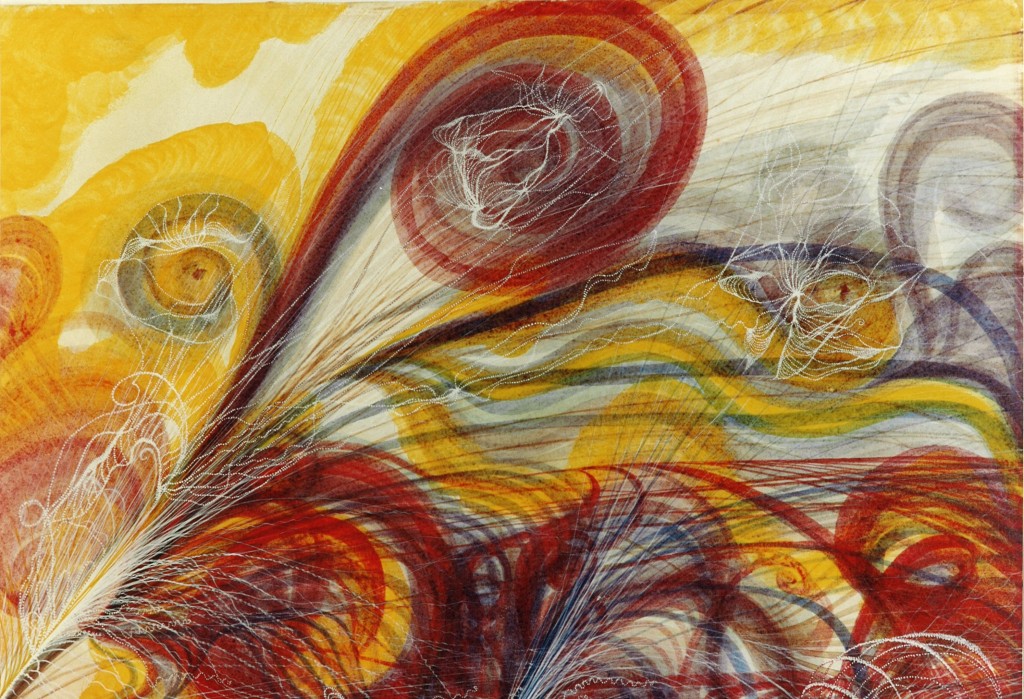Georgiana Houghton: Spirit Drawings Exhibition at The Courtauld Gallery, Somerset House, London
16 June – 11 September 2016

Georgiana Houghton’s remarkable Victorian abstract ‘spirit drawings’ are being exhibited in the United Kingdom for the first time since they were first shown in London in 1871. Houghton was a Victorian spiritualist and medium who pioneered the use of drawing as part of her process of communicating with the spirit realm. Largely unknown for nearly 150 years, these works are an astonishing product of Victorian culture and a fascinating precursor of twentieth-century abstract art. The birth of abstract art is typically associated with Kandinsky and others in the early twentieth century; however, Houghton’s work predates this momentous artistic breakthrough by half a century. In this respect, she anticipates the Swedish artist Hilma af Klint (1862-1944), whose work is now appreciated for its significance in the early history of abstraction.
Houghton was a prominent figure of the early spiritualist movement in Victorian England, which played a significant role in various spheres of nineteenth-century culture and was later championed by such influential figures as Sherlock Holmes author Sir Arthur Conan Doyle. Spiritualism emerged as the belief that contact with a spirit realm was possible and that such communication could bring one closer to God. Houghton, a trained artist as well as a medium, pioneered the use of drawing as a method of channelling and expressing communications with spirit entities. During the 1860s and 1870s, she produced a series of unprecedented abstract watercolours as part of her practice as a spirit medium. Houghton called these works ‘spirit drawings’. Houghton’s spirit drawings are remarkably complex and layered watercolours. Technically highly accomplished, their bold colours and fluid forms have a mesmerising and deeply absorbing effect. Detailed inscriptions on the back of the works declare that her hand was guided by various spirits, including family members, several Renaissance artists, such as Titian and Correggio and higher angelic beings. These inscriptions, which are a form of automatic writing, also make clear that Houghton’s richly patterned compositions are intended to be faithful visualisations of aspects of the spirit realm and designed to inspire and strengthen the spiritual life of their viewers.
Although produced in a very different context, Houghton’s abstract works have close connections to the ways in which twentieth- century artists developed abstract languages of art to transcend the everyday realm of representation and consciousness. In 1871 Houghton rented a prestigious gallery space in Bond Street and presented 155 of her spirit drawings to a perplexed London audience. The Critic from The Era newspaper pronounced it to be “The most astonishing exhibition in London at the present moment.” The Daily News likened the works to “tangled threads of coloured wool” and concluded that “They deserve to be seen as the most extraordinary and instructive example of artistic aberration.” Houghton carefully curated the exhibition and published a fascinating catalogue giving insights into the development of her work and encouraging visitors to engage themselves with the practice of spirit drawing. The exhibition proved to be a commercial failure and nearly bankrupted Houghton. Although she continued to make spirit drawings after the exhibition, her ambition of popularising the practice was not realised. Today, less than fifty of her works are known. The majority are in the collection of the Victorian Spiritualists’ Union in Melbourne, Australia. An album containing further examples is held by the College of Psychic Studies in London and will also be included in the exhibition.
Georgiana Houghton: Spirit Drawings at The Courtauld Gallery will present more than twenty of these remarkable works. Unlike anything typically associated with Victorian culture, it will be a fascinating opportunity to consider their place within the history of art; both as products of their times and as precursors of radical twentieth century art.
This exhibition forms part of the Gallery’s Summer Showcase programme, which considers unusual episodes or overlooked questions in the history of art. It is organised in collaboration with Monash University Museum of Art, Melbourne, Australia and the following team of curators: Simon Grant is a writer and art historian, editor of Tate Etc magazine and co-editor of Picpus magazine, and has contributed numerous catalogue essays on modern and contemporary artists. Lars Bang Larsen is an art historian, independent curator and writer based in Copenhagen. He has curated projects at the Stedelijk Museum, Amsterdam; Raven Row, London, and at the Bienal de São Paulo. Marco Pasi is Associate Professor in History of Hermetic Philosophy and related currents at the University of Amsterdam. His research focuses on the complex web of relations between modern Western esotericism, religion, politics and art.
A catalogue for the Georgiana Houghton exhibition has been published by the Courtauld Gallery as well as a one day symposium on September 7th 2016 about the artist.